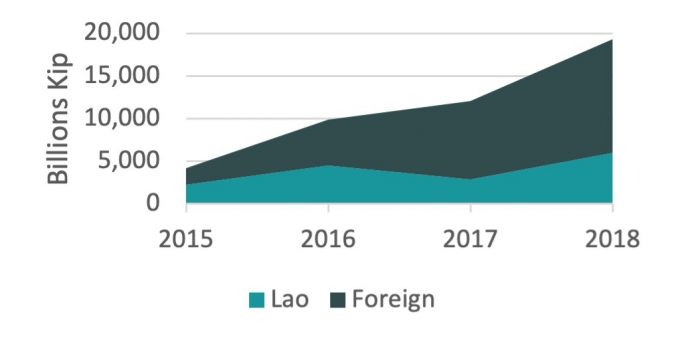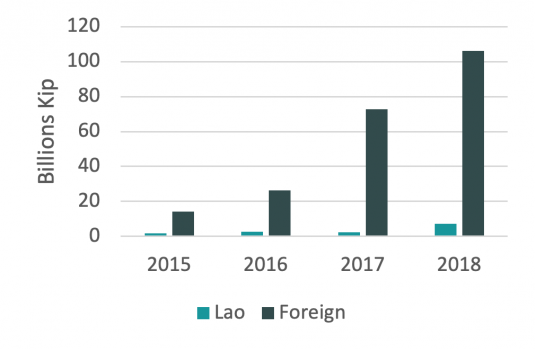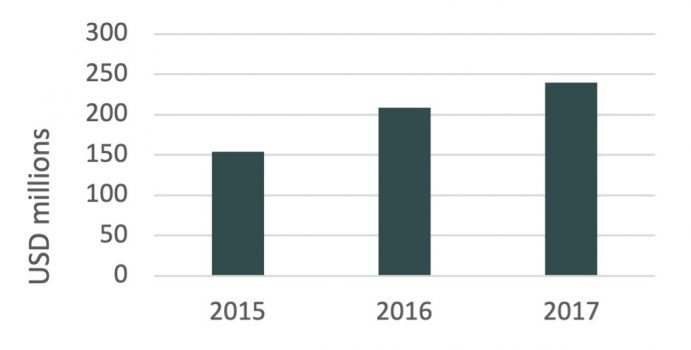Laos

GROWING DEMAND FOR INDUSTRIAL ZONE LAND IN LAOS
CHART – SUPPLY OF INDUSTRIAL STATE LAND IN LAOS

The development of an organised industrial sector took some time to gain momentum in Laos with only very limited progress in the nineties and the first decade of the century following the economic opening of the country and a shift of policy towards development of export orientated manufacturing. Early attempts at the development of SEZs were stymied by ineffective state ownership and management of the initial zones also lacking specific regulations and privileges.
The current decade saw a far more positive oversight of this sector with the passing of the Decree on Special and Specific Economic Zones in 2010 which provided the legal framework and incentives for investors such as generous tax benefits and long land lease periods.
The development of the SEZs was also mostly placed in the hands of private developers with more experience of industrial estate development with two large projects opening for sales (long-term lease basis) in 2012. Laos also benefitted from the floods in Thailand in 2011 which devastated industrial areas north of Bangkok and led many multinationals to diversify their supply chains to neighbouring countries such as Laos.
While many SEZs have either opened or are in planning stage throughout the country, only a handful are specifically zoned for industrial use. Others are focused on tourism, commercial or residential development and are therefore not included in this report.
CHART – STATUS OF SALES OF CURRENT INDUSTRIAL LAND IN LAO SEZs 2018

The existing SEZ industrial estates are now profiting from the growing interest in Laos with sold/reserved rates hitting over 50% of current supply after an initially slow start. Sales in the SEZs have gained momentum; especially with the entry of large, well-respected multinational manufacturers covering a diverse range of sectors including optical products, electronics, cable & wiring and aeronautical production.
Many manufacturers are locating to the industrial estates due to their proximity to Thailand and to a lesser degree Vietnam and other occupants are using the estates for supplies for the construction, mining and energy sectors that are growing rapidly in Laos. The development of infrastructure as a result of the BRI is also likely to be another expanding source of demand.
RISE OF THE MANUFACTURING SECTOR IN LAOS
CHART – INVESTMENT IN THE MANUFACTURING SECTOR IN LAOS

The manufacturing sector in Laos is increasingly dominated by foreign investors with nearly 70% of the total investment registered in 2018. Over the past ten years the two most significant investor countries have been China and Vietnam. While only a small proportion of such investment directly relates to industrial estate occupancy – the ripple effects have helped spur demand for suppliers who are more likely to locate in the SEZs.
CHART– AVERAGE INVESTMENT SIZE IN THE MANUFACTURING SECTOR

As well as a steady increase in investment into Laos for manufacturing, the average size of such investments has also been amplified especially from foreign investors. Laos has become more integrated into regional supply chains in conjunction with greater infrastructure spending in mostly transport and energy. This has led to larger undertakings in the manufacturing sector which has opened up opportunities for local based suppliers supporting larger operations in Laos.
FROM “LAND-LOCKED” TO “LAND-LINKED”
Laos has for a long time suffered under its geographical position of being a land-locked country where industrialization is hampered partly due to a lack of direct sea access. In recent years Laos has used the expression “land-linked” providing a more positive spin. However the development of the industrial sector over the past five years has shown that the expression has some substance. The SEZs that contain industrial zones are all close to international borders, especially Thailand.
Firstly manufacturing in Laos can be integrated into the regional supply chains due to convenient border access. In the case of Savan Park SEZ, located near the southern city of Savannakhet, a cross-border transport agreement between Laos, Thailand and Vietnam speeds up the customs process with goods inspected and sealed by Lao customs officials in the facility requiring no further declarations at the borders of Thailand or Vietnam. Goods can then be transported to often Laem Chabang deep sea port in Thailand or Danang in Vietnam and onwards to Europe, Japan or the US. Also some high value products can also be transhipped to Suvarnabhumi Airport in Thailand with similar streamlined custom processes. This allows exporters to benefit fully from the Generalized System of Preferences (GSP) regime for their main export destinations.
CHART– GARMENT EXPORTS TO THE EUROPEAN UNION USING GSP TRADING PRIVILLEGES

Laos, like other countries in regions such as Myanmar and Cambodia are able to trade with the European Union (EU) and other countries under specific privileges for least developed nations under the GSP that allows tariff free entry for most products. One sector that is starting to take advantage is the garment industry where low wages and increasingly efficient supply chains are leading many to locate to Laos with exports increasing steadily since 2015. Germany, Sweden and the UK are the main export destinations. Japan is also a significant importer of products from Laos especially for footwear with a more than doubling in export value from 2016 to 2017.
Another growth area is through the EU’s GSP Cumulation of Origin system which allows Laos in certain conditions for manufacturing inputs from its neighbouring countries, especially Thailand and Vietnam, to be considered as originating in the final product exporting country. This means that Thai and Vietnamese based manufacturers can use Laos as the final assembly plant and gain tariff free access to EU markets as a result. This is one of the reasons for the popularity of the SEZs that are close or connected by good road to the Thai and Vietnamese borders.
POTENTIAL FOR LOGISTICS SECTOR
Laos is geographically located in an increasingly economically strategic location with neighbouring China to its north and Thailand to its south which for China represents an important gateway to South East Asia especially Singapore and its deep sea port. Laos also serves as a connector to the other significant rising economies of Myanmar and Vietnam. As trade develops among these countries and regionally interconnected supply chains become more prevalent, Laos is in a position to benefit enormously from such positive changes.
Laos is one of China’s most important partners for its BRI, evident by the progress being made on the construction of the high-speed railway connecting Yunnan in China to the Laotian capital of Vientiane. The development is mostly focused on promoting increased freight transport from China through Laos and onwards to South East Asia. Currently Laos has only a negligible length of track covering the short distance from Vientiane to the Thai border.
CHART – ROAD LENGTH IN LAOS

Roads provide the most significant means of freight transport in Laos, including manufactured goods. Over the past years there has been a rise in the amount of freight travelling on roads. It is expected to further increase as trade grows further within Laos and between its powerful neighbours. The mountainous northern road linking Vientiane with China is undergoing upgrading and the East-West corridor linking Myanmar, Thailand, Laos and Vietnam is also a key facilitator for more efficient trade, with the southern city of Savannakhet already benefitting.
There are therefore significant opportunities for the development of more sophisticated logistics set ups that could serve the growing trade transportation within Laos such as storage, multi-modal logistics, freight forwarding, bonded warehouses, truck stops, repair services as well as additional packaging and labelling services.
Over the past ten years Laos has made some progress in extending and improving its road network and it is expected that further development will be made in this decade.

THE INDUSTRIAL FUTURE FOR LAOS
The country of Laos contains seven million people and is sparsely populated. Currently labour supply in the SEZs is not a significant issue although generally the skill levels of the local labour force can be challenging along with adapting to a shift culture mentality; but these are not serious impediments. Foreign managers and supervisors often from Thailand are brought in initially but later to be supplanted by trained locals.
However, given the population it would be difficult to visualise Laos ever becoming a serious industrial player that can compete in sheer quantity to Vietnam or Thailand. Also, with a small population many manufacturers in Laos will only focus on export related goods rather than products that can serve the local market.
The private sector with government support has been successful in the reversal of fortunes for the SEZs and is expected to remain the best direction to spread industrial zone development to other parts of the country. This compares favourably to Myanmar in which the state operates most industrial estates leading to very poor management and a lack of essential services such as regular power and waste disposal.
Laos as the “Battery of Asia” with its substantial hydropower can provide relatively cheap and reliable electricity and the government offers a one-stop service for investment submission and approval. The private SEZs offer good internal roads along with direct access to national highways as well as waste water treatment and electricity sub-stations. Flooding is also not an important issue for the current SEZs.
One of main areas of focus for the further industrial development for Laos is to harness the potential for the logistics sector for the next few decades as Asia becomes the main global economic powerhouse combined with the country’s geographical positioning in this future trading web. In 2019 Laos will implement a reduction of tariffs for its ASEAN partners for a significant number of products as part of the ASEAN Free Trade Area. This will be expected to further boost trade supporting both manufacturing and logistics.
With government support for further transport infrastructure development plus allowing the private sector to lead the way with efficient logistics and industrial hubs, the industrial/logistics sector in Laos can play a fundamental part in its quest to graduate from Least Developed Country status to that of a middle-income country over the next ten years.
